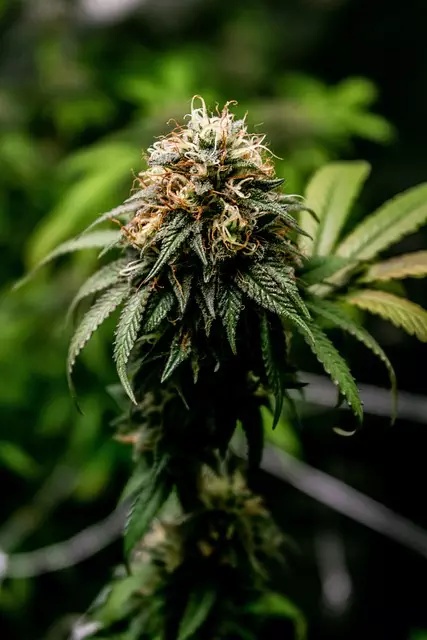The text explores the world of high-potency cannabinoids (HPCs), focusing on THC and CBD, their therapeutic effects, and their growing popularity in the medical cannabis industry. It highlights how HPCs offer precise dosing for tailored relief from conditions like anxiety, pain, and inflammation. Safety is emphasized, with a need for purity, dosage awareness, and understanding personal tolerance to avoid risks. The regulatory landscape varies globally, with some regions implementing strict rules for consumer protection, while standardization is sought to ensure safer access to HPC products. This shift towards HPCs meets the demand for natural solutions, providing diverse options for targeted health management.
“Exploring the World of High Potency Cannabinoids: Unlocking Benefits and Navigating Safety. In the realm of cannabis, understanding cannabinoid potency is key. This article delves into the intricacies of high-potency cannabinoids, their definitional characteristics, and the diverse products they power. From concentrated extracts to innovative formulations, we examine how these powerful compounds are reshaping the industry. Additionally, we explore safety considerations, regulatory implications, and future trends, providing a comprehensive guide to the dynamic landscape of high potency cannabinoids.”
Understanding Cannabinoid Potency: The Basics

Cannabis products vary greatly in their cannabinoid content, with potency levels measured in milligrams per gram (mg/g) or parts per million (ppm). High potency cannabinoids like THC and CBD are the primary compounds of interest due to their therapeutic effects. THC, for instance, is known for its psychoactive properties, offering relief from anxiety, pain, and inflammation, while also stimulating appetite. In contrast, CBD has gained popularity for its potential non-psychoactive benefits in managing stress, reducing muscle spasms, and promoting better sleep without the mental alteration associated with THC.
Understanding potency is crucial when selecting a product to suit individual needs. High-potency cannabis may provide more intense effects but requires careful use due to its strength. Lower-potency options are ideal for those new to cannabis or seeking milder experiences, allowing them to gauge their tolerance and adjust accordingly. The right choice ultimately depends on personal preferences, desired outcomes, and the specific medical conditions being addressed.
High Potency Cannabinoids: Definition and Benefits

High-potency cannabinoids refer to compounds derived from cannabis plants that possess significantly higher concentrations of cannabinoid molecules, particularly tetrahydrocannabinol (THC) and cannabidiol (CBD). These potent substances offer a range of potential benefits due to their ability to interact with the endocannabinoid system in our bodies. THC, for instance, is known for its psychoactive effects, providing relief from anxiety, chronic pain, and stimulating appetite.
On the other hand, CBD, despite not having psychoactive properties, has gained popularity for its anti-inflammatory, anticonvulsant, and anxiolytic (anxiety-reducing) effects. High-potency cannabinoids allow for more precise dosing and targeted relief, making them a game-changer in the medical cannabis field. They enable patients to manage various conditions effectively while minimising unwanted side effects.
Products with High Cannabinoid Concentrations

Products boasting high concentrations of cannabinoids, particularly THC and CBD, are gaining popularity among consumers seeking potent and effective relief. These products offer a wide range of benefits, from managing chronic pain and reducing anxiety to promoting better sleep and enhancing overall well-being. The market has seen an influx of various options, including concentrated oils, tinctures, and high-potency edibles, catering to diverse consumer preferences.
For individuals looking for intense therapeutic effects, products with elevated cannabinoid levels provide a more robust experience. High-potency cannabinoids allow for precise dosing, ensuring consumers can tailor their intake to specific needs. This customization is especially beneficial for those managing severe symptoms or requiring targeted relief for particular conditions.
Safety Considerations for High-Potency Products

When it comes to high-potency products, safety considerations take on added importance. These products often contain elevated levels of cannabinoids, which can intensify their effects—both positive and potentially negative. It’s crucial for consumers to understand that while higher potency may offer enhanced therapeutic benefits, it also necessitates a heightened sense of awareness.
Key safety measures include ensuring product purity, understanding dosage guidelines, and recognizing personal tolerance levels. High-potency cannabinoids demand careful manufacturing processes to guarantee the absence of contaminants or adulterants. Moreover, consumers should adhere to recommended serving sizes and allow for adequate time between doses to gauge their body’s response, thereby mitigating risks associated with an overdose or unexpected side effects.
Regulatory Landscape and Consumer Protection

The regulatory landscape surrounding high potency cannabinoids (HPCs) is complex and ever-evolving, with consumer protection at its core. As the legal status of cannabis products varies globally, so too do the regulations around HPCs, leading to diverse approaches in different markets. In regions where cannabis is fully legalized, strict guidelines often dictate product quality, labeling, and safety standards, ensuring consumers access reliable and safe HPC products. These regulations encompass testing methods, ingredient traceability, and clear warnings about potential risks and effects.
For example, some countries mandate third-party lab testing for cannabinoid content and contaminants, while others require detailed product information regarding cannabinoid profiles. Consumer protection measures in these areas aim to prevent misleading claims and ensure that consumers understand the potency and potential impacts of HPCs. As the cannabis industry continues to grow, so too does the need for harmonized regulations worldwide, fostering a safer and more accessible environment for legal HPC products while protecting consumers from potentially harmful or unregulated offerings.
Future Trends: Innovations in High Potency Cannabinoid Offerings

The future of cannabis products looks bright with a growing focus on high potency cannabinoids. As consumer demand for potent and effective remedies increases, researchers and brands are pushing the boundaries of what’s possible. Innovations in extraction methods and cultivation techniques have led to remarkable advancements in cannabinoid profiles, allowing for more precise dosages and tailored treatments.
High-potency products, previously accessible only through black markets, are now entering the mainstream. Legalization has opened doors for scientific exploration, leading to the development of advanced formulations that cater to specific health needs. From CBD-dominant oils to THC-rich concentrates, the market is evolving to meet the diverse preferences and requirements of consumers seeking natural solutions for pain management, anxiety relief, and sleep aid, among other applications.



